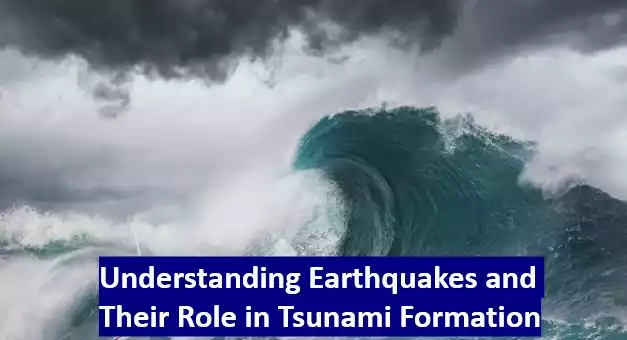Understanding Earthquakes and Their Role in Tsunami Formation
Two successive earthquakes measuring 7.7 and 6.4 struck Myanmar on Friday, with Bangkok, Thailand’s capital, experiencing significant shocks that collapsed a high-rise building and forced the authorities to declare an emergency and suspend metro and rail service.
Earthquakes, among the most devastating natural disasters, are capable of triggering an event even more catastrophic: a tsunami. Tsunamis, often confused with regular waves, are far more powerful and destructive. But what is the exact relationship between earthquakes and tsunamis? How do earthquakes create these massive oceanic waves that wreak havoc across coastal regions? In this article, we will delve into the scientific phenomena that link these two events, exploring how earthquakes generate tsunamis, the mechanisms involved, and the factors that influence their scale and impact.
What is an Earthquake?
An earthquake occurs when there is a sudden release of energy beneath the Earth’s surface, typically caused by the movement of tectonic plates. The Earth’s crust is divided into several large plates that float atop the semi-fluid mantle. As these plates move over time, they may grind against each other, creating friction. When this stress exceeds the strength of the rocks, the energy stored in these rocks is released in the form of seismic waves, causing the ground to shake.
Earthquakes are commonly classified based on the type of fault movement:
- Strike-slip: Plates slide past each other horizontally.
- Normal: One plate moves downward relative to the other.
- Reverse (or Thrust): One plate is forced upward over the other.
The severity of an earthquake is measured using the Richter scale, which quantifies the magnitude of the seismic waves produced.
What is a Tsunami?
A tsunami is a series of large, powerful ocean waves caused by the sudden displacement of a large volume of water. Unlike typical ocean waves driven by wind, tsunamis are typically triggered by underwater earthquakes, volcanic eruptions, or landslides. These waves can travel at speeds up to 500 miles per hour across the open ocean and, upon reaching coastal areas, can cause extreme flooding and destruction.
Tsunamis are different from regular waves in several critical ways. First, their wavelengths are much longer, and they often involve entire water columns from the ocean surface down to the seabed. This allows them to carry immense energy over vast distances.
The Relationship Between Earthquakes and Tsunamis
The Role of Submarine Faults in Tsunami Generation
The vast majority of tsunamis are triggered by earthquakes that occur along subduction zones—regions where one tectonic plate is forced beneath another. In these areas, the Earth’s crust is under immense pressure due to the constant movement of the plates. When an earthquake occurs in these zones, it can cause a sudden displacement of the seafloor. This shift in the ocean floor moves a massive amount of water, which is then displaced and forms a tsunami.
The mechanisms involved are as follows:
- Tectonic Plate Movement: At subduction zones, one tectonic plate is forced beneath another, creating a large fault. The stress builds up over time as the plates continue to move.
- Sudden Seafloor Displacement: When the stress becomes too great, the plates slip suddenly, causing a large section of the seafloor to move vertically. This vertical displacement displaces water above it.
- Wave Propagation: The displaced water creates waves that propagate outward from the epicenter of the earthquake. These waves can travel across the ocean at speeds of up to 500 miles per hour, causing them to reach distant shores.
- Wave Amplification: As the tsunami waves approach the shallow coastal waters, their speed decreases and their height increases due to the compression of the wave’s energy.
Types of Earthquakes That Cause Tsunamis
Not all earthquakes lead to tsunamis, as the type of movement and the location of the earthquake play crucial roles. The following types of earthquakes are particularly prone to generating tsunamis:
- Subduction Zone Earthquakes: These occur at convergent plate boundaries where one tectonic plate is forced beneath another. The sudden vertical displacement of the seafloor causes the water above to shift, resulting in a tsunami.
- Thrust Fault Earthquakes: These earthquakes, typically occurring at subduction zones, also cause vertical displacement of the seafloor, leading to tsunami formation.
Factors That Influence Tsunami Size and Impact
While the occurrence of an earthquake may lead to a tsunami, the size and severity of the tsunami are influenced by several factors. These include:
1. Magnitude of the Earthquake
The magnitude of the earthquake plays a critical role in determining the size of the tsunami. Larger earthquakes, with magnitudes of 7.5 or higher, are more likely to cause significant vertical displacement of the seafloor, resulting in larger waves. Earthquakes with smaller magnitudes may not cause enough displacement to generate a tsunami.
2. Depth of the Earthquake
The depth at which the earthquake occurs also impacts the tsunami. Shallow earthquakes, occurring at depths of less than 100 kilometers, are more likely to produce tsunamis due to the closer proximity of the earthquake’s focus to the ocean floor. Deeper earthquakes, on the other hand, may not displace the water enough to generate significant waves.
3. Location of the Earthquake
The proximity of the earthquake to the ocean is a key factor. Earthquakes that occur directly beneath the ocean floor, especially near the coast, are more likely to trigger tsunamis than those that occur on land or in deep oceanic regions.
4. Seafloor Topography
The structure and shape of the seafloor can amplify or reduce the height of tsunami waves. Coastal areas with steep slopes may experience more powerful waves, while regions with gradual slopes might see smaller waves.
5. Duration and Type of Faulting
The duration and type of faulting (whether strike-slip, normal, or reverse) can also affect the amount of seafloor displacement. Reverse faults, which are common in subduction zones, are particularly effective at displacing large volumes of water.
Case Studies of Earthquakes and Tsunami Events
The 2004 Indian Ocean Tsunami
One of the most devastating tsunamis in modern history was triggered by a massive undersea earthquake off the coast of Sumatra, Indonesia, on December 26, 2004. The earthquake, with a magnitude of 9.1-9.3, occurred along a subduction zone between the Indo-Australian and Eurasian plates. The seafloor was displaced by several meters, displacing billions of tons of water and generating a series of massive waves that traveled across the Indian Ocean. The tsunami caused widespread devastation in countries like Indonesia, Sri Lanka, India, and Thailand, resulting in over 230,000 deaths.
The 2011 Tōhoku Earthquake and Tsunami
On March 11, 2011, Japan experienced a magnitude 9.0 earthquake along a subduction zone off the east coast. The earthquake triggered a massive tsunami that reached heights of up to 40 meters, causing catastrophic flooding and leading to significant damage, including the Fukushima nuclear disaster. The tsunami waves traveled across the Pacific Ocean, reaching the coasts of North and South America.
Preventing Tsunami Damage
While it is impossible to prevent tsunamis, there are measures that can be taken to mitigate their impact:
- Early Warning Systems: By detecting seismic activity and oceanic changes, early warning systems can alert coastal populations about impending tsunamis, allowing them time to evacuate.
- Tsunami-Resilient Infrastructure: Building coastal structures designed to withstand tsunami waves, such as reinforced sea walls and elevated buildings, can help reduce damage.
- Public Awareness and Preparedness: Educating coastal communities about tsunami risks and evacuation plans can save lives during a tsunami event.
Conclusion
Understanding the connection between earthquakes and tsunamis is essential for preparing and mitigating the impact of these natural disasters. By studying the mechanisms behind earthquake-triggered tsunamis, scientists can improve early warning systems, design resilient infrastructure, and increase public awareness to minimize the loss of life and property. As we continue to monitor seismic activity and refine our response strategies, we can hope to better protect vulnerable coastal regions from the devastating effects of tsunamis.
You May Like
Trending Searches Today |
ODISHA: President Droupadi Murmu To Visit Odisha Today
Tata Power: Consumer Group Protests in Bhubaneswar Over Tariff Hike Plan




